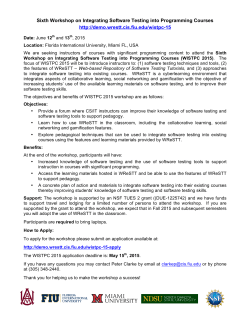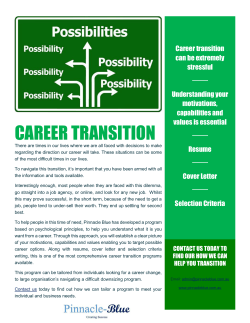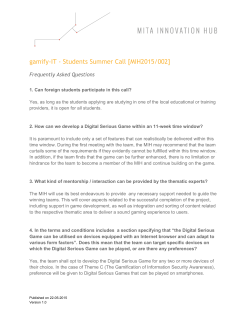
cfp - gamification 49th annual hawaii international conference on
CFP - GAMIFICATION MOTIVATIONS, EFFECTS AND ANALYTICS 49TH ANNUAL HAWAII INTERNATIONAL CONFERENCE ON SYSTEM SCIENCES (HICSS 2016) IMPORTANT DATES: June 15: Submissions deadline August 16: Notification sent to authors September 4: Revision deadline September 10: Final acceptance notifications sent to authors September 15: Deadline for authors to submit the final manuscript (camera ready) within “Decision Analytics, Mobile Services, and Service Science” - track INFORMATION: 49th annual Hawaii International Conference on System Sciences HICSS: January 5-8, 2016 @ Grand Hyatt, Kauai Venue & Location About the conference Submission instructions During the last decade games have become an established vein of entertainment, consumer culture, and essentially, a common part of people’s daily lives [19]. In the United States alone 59% of the population plays computer games while revenues of the computer games industry exceed US $15 billion (ESA, 2014). However, in addition to the increased penetration of games, also the ways in which people play and employ games have become more varied. The long-tail is getting longer: there are more different kinds of games available for multitude of different platforms that cater for differing gaming needs [8,11,15,23,24] for widening audiences [1,2,3,12,13,14,16,19,21,22,23] and which use a wide variety of business models [7,10]. Especially the free-to-play revenue model [5,17,20], which enables developers to offer major parts of the game for free, has further fed into this development. Perhaps the most prominent development related to games and information systems is “GAMIFICATION” which generally refers to the increased convergence of games and everyday life. More particularly gamification is also commonly related to the process of enhancing services/systems so that they increase enjoyable and intrinsically motivated use as well as further behavioural change by employing elements characteristic of games - “Transforming Homo Economicus into Homo Ludens” [4,6,9,18,25]. As HICSS is addressing leading edge interdisciplinary developments, we encourage a wide range of submissions: empirical and conceptual research papers, case studies, reviews as well as practitioner reports related to gamification, games, information systems, commerce and users/players as well as the area between them. Relevant topics include (not limited to): Impact of games and gamification o Individual impact Behaviour Psychological states Well-being o Organizational impacts o Business benefits o Societal impacts Conceptual improvements o Definitions o Frameworks o Affordances / mechanics Game business o Free-to-play o Virtual goods o Player retention o Game design as marketing Motivations and players o Player typologies o Player motivations o What needs games satisfy o Demographic differences o adoption and continued use Technology and design o Mobile and web applications o Gamification in enterprise systems and decision support systems o Health applications o Education technology (serious games) o Design philosophies o User modelling o (Action) Design research Accepted papers will be included in the Conference Proceedings published by the IEEE Computer Society and maintained in the IEEE Digital Library. HiCSS publications account for the top 2% downloads of all IEEE conferences, and have been consistently ranked as the most cited papers in top journal publications. TRACK CHAIRS Juho Hamari (Primary Contact) Game Research Lab / University of Tampere Email: juho.hamari@uta.fi Petri Parvinen Aalto University School of Science Email: petri.parvinen@aalto.fi REFERENCES: 1. Greenberg, B. S., Sherry, J., Lachlan, K., Lucas, K. & Holmstrom, A., 2010. Orientations to video games among gender and age groups. Simulation and Gaming, 41(2), 238-259. 2. Griffiths, M. D., Davies, M. N. O. & Chappell, D., 2003. Breaking the stereotype: The case of online gaming. CyberPsychology and Behavior, 6(1), 81-91. 3. Griffiths, M. D., Davies, M. N. O. & Chappell, D., 2004. Demographic factors and playing variables in online computer gaming. Cyberpsychology and Behavior, 7(4), 479-487. 4. Hamari, J., 2013. Transforming Homo Economicus into Homo Ludens: A Field Experiment on Gamification in a Utilitarian Peer-To-Peer Trading Service. Electronic Commerce Research and Applications, 12(4), 236-245. 5. Hamari, J., 2015. Why Do People Buy Virtual Goods? Attitude towards Virtual Good Purchases versus Game Enjoyment. International Journal of Information Management, 35 (3), 299-308. 6. Hamari, J., Huotari, K. & Tolvanen, J., 2015. Gamification and Economics. In S. P. Walz & S. Deterding (Eds.), The Gameful World: Approaches, Issues, Applications (pp. 139-161). Cambridge, MA: MIT Press. 7. Hamari, J. & Järvinen, A., 2011. Building Customer Relationship through Game Mechanics in Social Games. in M. Cruz-Cunha, V. Carvalho, and P. Tavares (Eds.) Business, Technological and Social Dimensions of Computer Games: Multidisciplinary Developments Hershey, PA: IGI Global, 348-365. 8. Hamari, J., Keronen, L. & Alha, K., 2015. Why Do People Play Games? A Review of Studies on Adoption and Use. In proceedings of the 48th Annual Hawaii International Conference on System Sciences, Hawaii, USA, January 5-8, 2015. 9. Hamari, J., Koivisto, J. & Sarsa, H., 2014. Does Gamification Work? – A Literature Review of Empirical Studies on Gamification. In proceedings of the 47th Annual Hawaii International Conference on System Sciences, Hawaii, USA, January 6-9, 2014. 10. Hamari, J. & Lehdonvirta, V., 2010. Game Design as Marketing: How Game Mechanics Create Demand for Virtual Goods. International Journal of Business Science & Applied Management, 5(1), 14-29. 11. Hamari, J. & Tuunanen, J., 2014. Player types: A meta-synthesis. Transactions of the Digital Games Research Association, 1(2), 29-53. 12. Hartmann, T. & Klimmt, C., 2006. Gender and computer games: Exploring females’ dislikes. Journal of Computer-Mediated Communication, 11(4), 910-931. 13. Ijsselsteijn, W., Nap, H. H., de Kort, Y. & Poels, K., 2007. Digital game design for elderly users. In Proceedings of the 2007 conference on Future Play, Toronto, Canada, November 15-17, 17-22. 14. Jansz, J., Avis, C. & Vosmeer, M., 2010. Playing The Sims2: An exploration of gender differences in players’ motivations and patterns of play. New Media & Society, 12(2), 235251. 15. Kallio, K. P., Mäyrä, F. & Kaipainen, K., 2011. At Least Nine Ways to Play: Approaching Gamer Mentalities. Games and Culture, 6(4), 327-353. 16. Koivisto, J. & Hamari, J., 2014. Demographic differences in perceived benefits from gamification. Computers in Human Behavior, 35, 179-188. 17. Lin, H. & Sun, C. T., 2011. Cash trade in free-to-play online games. Games and Culture, 6(3), 270-287. 18. McGonigal, J., 2011. Reality is broken: Why games make us better and how they can change the world. Penguin Press. 19. Mäyrä, F. & Ermi, L., 2014. Pelaajabarometri 2013. Mobiilipelaamisen Nousu. TRIM Research Reports: 11, University of Tampere. 20. Paavilainen, J., Hamari, J., Stenros, J. & Kinnunen, J., 2013. Social Network Games: Players’ Perspectives. Simulation & Gaming, 44(6), 794-820. 21. Williams, D., Consalvo, M., Caplan, S. & Yee, N., 2009. Looking for gender: Gender roles and behaviors among online gamers. Journal of Communication, 59(4), 700-725. 22. Williams, D., Yee, N. & Caplan, S. E., 2008. Who Plays, How Much, and Why? Debunking the Stereotypical Gamer Profile. Journal of Computer‐Mediated Communication, 13(4), 9931018. 23. Yee, N., 2006. The demographics, motivations and derived experiences of users of massivelymultiuser online graphical environments. PRESENCE: Teleoperators and Virtual Environments, 15, 309-329. 24. Yee, N., 2007. Motivations for play in online games. CyberPsychology and Behavior, 9(6), 772-775. 25. Walz, S. & Deterding, S., (Eds.)., 2015. The Gameful World: Approaches, Issues, Applications. Cambridge, MA: MIT Press.
© Copyright 2025












